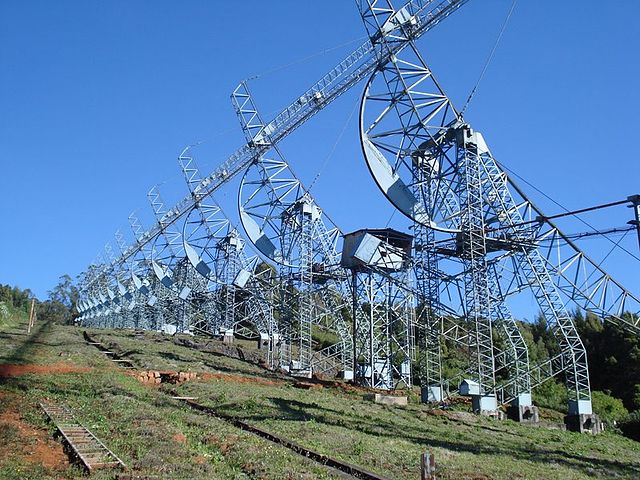Molonglo Observatory Synthesis Telescope
The Molonglo Observatory Synthesis Telescope (MOST) is a radio telescope operating at 843 MHz. It is operated by the School of Physics of the University of Sydney. The telescope is located in Hoskinstown, near the Molonglo River and Canberra, and was constructed by modification of the east–west arm of the former Molonglo Cross Telescope, a larger version of the Mills Cross Telescope. Construction of the original "Super Cross" telescope with 1.6-kilometre arms began in 1960 by Professor Bernard Y. Mills. It became operational in 1967.
Molonglo Observatory Synthesis Telescope
MOST looking along E-W arm from the west.
MCT antennas looking along remaining N-S arm from the north.
Reber memorial
A radio telescope is a specialized antenna and radio receiver used to detect radio waves from astronomical radio sources in the sky. Radio telescopes are the main observing instrument used in radio astronomy, which studies the radio frequency portion of the electromagnetic spectrum emitted by astronomical objects, just as optical telescopes are the main observing instrument used in traditional optical astronomy which studies the light wave portion of the spectrum coming from astronomical objects. Unlike optical telescopes, radio telescopes can be used in the daytime as well as at night.
The 64-meter radio telescope at Parkes Observatory as seen in 1969, when it was used to receive live televised video from Apollo 11
Antenna of UTR-2 low frequency radio telescope, Kharkiv region, Ukraine. Consists of an array of 2040 cage dipole elements.
Full-size replica of the first radio telescope, Jansky's dipole array of 1932, preserved at the US Green Bank Observatory in Green Bank, West Virginia.
Ooty radio telescope, a 326.5 MHz dipole array in Ooty, India








